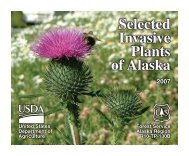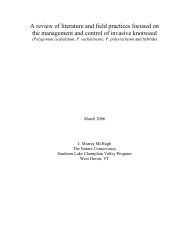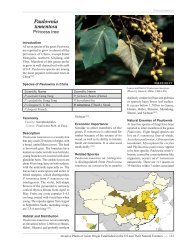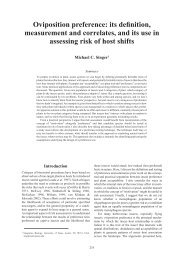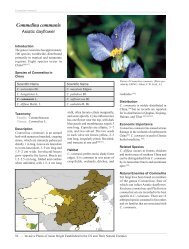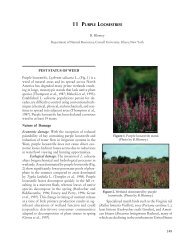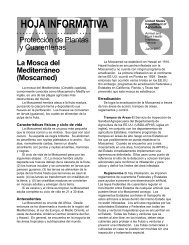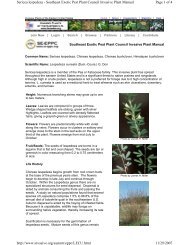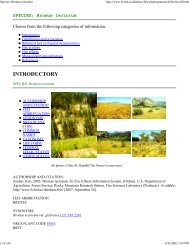5 WATERLETTUCE PEST STATUS OF WEED ... - Invasive Plants
5 WATERLETTUCE PEST STATUS OF WEED ... - Invasive Plants
5 WATERLETTUCE PEST STATUS OF WEED ... - Invasive Plants
Create successful ePaper yourself
Turn your PDF publications into a flip-book with our unique Google optimized e-Paper software.
5 <strong>WATERLETTUCE</strong><br />
F. Allen Dray, Jr. and Ted D. Center<br />
U.S. Department of Agriculture, Agricultural Research Service, <strong>Invasive</strong> Plant Research Laboratory,<br />
Fort Lauderdale, Florida, USA<br />
<strong>PEST</strong> <strong>STATUS</strong> <strong>OF</strong> <strong>WEED</strong><br />
Waterlettuce, Pistia stratiotes L., (Fig. 1) is a floating,<br />
herbaceous hydrophyte first recorded from Florida<br />
during the 18 th century (Stuckey and Les, 1984). It<br />
forms extensive mats (Fig. 2) capable of blocking navigational<br />
channels, impeding water flow in irrigation<br />
and flood control canals, and disrupting submersed<br />
animal and plant communities (Sculthorpe, 1967;<br />
Attionu, 1976; Bruner, 1982; Sharma, 1984).<br />
Waterlettuce is among the world’s worst weeds<br />
(Holm et al., 1977). It has been placed on prohibited<br />
plant lists in Florida (FDEP, 2000), Louisiana<br />
(LDWF, 2000), Mississippi (MDAC, 1997), and Texas<br />
(TPWD, 2000), and is considered a noxious species<br />
(an invasive species of concern, but not regulated) in<br />
South Carolina (SCDNR, 2000) and Delaware<br />
(DDFW, 2000).<br />
Figure 1. The waterlettuce, Pistia<br />
stratiotes L. (Photograph<br />
courtesy of USDA, ARS<br />
<strong>Invasive</strong> Plant Research<br />
Laboratory.)<br />
Figure 2. A severe waterlettuce (Pistia stratiotes<br />
L.) infestation on Lake Okeechobee in<br />
southern Florida. (Photograph courtesy of<br />
USDA, ARS <strong>Invasive</strong> Plant Research<br />
Laboratory.)<br />
Nature of Damage<br />
Economic damage. Waterlettuce is a serious weed of<br />
rice crops in other countries (Suasa-Ard, 1976), but<br />
has not been reported as interfering with production<br />
in the United States. It also can interfere with hydroelectric<br />
operations (Napompeth, 1990), but has<br />
not done so in the United States. Consequently, direct<br />
losses attributable to waterlettuce result primarily<br />
from restricted water flow in irrigation and flood<br />
control canals in Florida. Unfortunately, the economic<br />
costs associated with such damage have not<br />
been quantified, but federal and state waterlettuce<br />
control operations in Florida cost nearly $650,000<br />
annually (Center, 1994). Other states treat intermittently<br />
as nuisance populations arise, but seldom more<br />
than a few hundred acres each year. Estimates of<br />
expenditures by local agencies and private agricultural<br />
interests are unavailable.<br />
Indirect losses accrue when large floating mats<br />
interfere with recreational activities such as boating<br />
and fishing, but these have not been quantified. Also,<br />
several species of mosquitoes that breed on<br />
waterlettuce are important vectors of malaria,<br />
65
Biological Control of <strong>Invasive</strong> <strong>Plants</strong> in the Eastern United States<br />
encephalitis, and filariae (Dunn, 1934; Bennett, 1975;<br />
Lounibos and Dewald, 1989; Lounibos et al., 1990).<br />
Outbreaks of St. Louis encephalitis are generally rare;<br />
there were 223 reported cases with 13 deaths in<br />
Florida in 1990 and nine cases (one death) in 1997<br />
(FDOH, 2000a). Equine encephalitis, also vectored<br />
by mosquitoes associated with waterlettuce, affects<br />
about 50 horses in Florida each year as well (FDOH,<br />
2000b). Costs associated with these diseases are unknown,<br />
and the portion of mosquito control operations<br />
directed toward waterlettuce-borne mosquitoes<br />
has not been reported.<br />
Ecological damage. There are few reports of deleterious<br />
ecological impacts associated with P.<br />
stratiotes infestations and these studies have generally<br />
been limited in scope. Sculthorpe (1967), for instance,<br />
noted that the intertwined root systems (composed<br />
of long adventitious roots arrayed with copious<br />
lateral rootlets) of extensive infestations accelerate<br />
siltation rates as they slow water velocities in rivers<br />
and streams (see also Anonymous, 1971). The<br />
resultant degradation of benthic substrates under<br />
these infestations has never been studied directly, but<br />
accelerated siltation often renders the affected<br />
benthos unsuitable as nesting sites for various fish<br />
species (Beumer, 1980) and as macroinvertebrate<br />
habitat (Roback, 1974). The accumulation of<br />
waterlettuce-generated detritus under large infestations<br />
only adds to this problem, and likely increases<br />
sediment and nutrient loadings much as it does under<br />
waterhyacinth mats (Schmitz et al., 1993). Furthermore,<br />
Sridhar (1986) reports that waterlettuce can<br />
bioaccumulate considerable amounts of heavy metals,<br />
so the detritus under some mats could be toxic.<br />
The waters under dense waterlettuce populations<br />
in lakes can become thermally stratified<br />
(Sculthorpe, 1967; Attionu, 1976), with reduced dissolved<br />
oxygen levels and increased alkalinity (Yount,<br />
1963; Attionu, 1976; Sridhar and Sharma, 1985). Prolonged<br />
oxygen deficits reduce plankton abundance<br />
(Hutchinson, 1975), and cause increased mortality of<br />
fish (Ayles and Barica, 1977; Clady, 1977) and<br />
macroinvertebrates (Roback, 1974; Cole, 1979). Although<br />
these effects likely occur in waterlettucedominated<br />
systems, they have not been investigated.<br />
Finally, Sharma (1984) reported that the evapotranspiration<br />
rate over a waterlettuce mat in one African<br />
lake was ten-fold greater than the evaporation rate<br />
over open water (but see the discussion on this topic<br />
and common misconceptions in Allen et al., 1997).<br />
However, the implications of this finding for hydrologic<br />
cycles in U.S. waterways has not been determined.<br />
Extent of losses. In Florida, waterlettuce infests<br />
about 2,500 acres of public waterways (after control<br />
operations), and a large, but uncounted number of<br />
acres of irrigation and flood control canals (Schardt,<br />
1992). Based on the annual costs associated with controlling<br />
waterlettuce on at least 10,000 acres of public<br />
waterways (Schardt, 1992; Center, 1994), it is reasonable<br />
to estimate that total expenditures exceed $1<br />
million annually in Florida. Other states in the eastern<br />
United States spend a combined total of less than<br />
$100,000/yr on waterlettuce control.<br />
Geographical Distribution<br />
Paleobotanical evidence suggests that prior to the<br />
Pleistocene the genus Pistia extended well beyond its<br />
present range into what is now temperate Asia, Europe,<br />
and North America (Dorofeev, 1955, 1958,<br />
1963; Friis, 1985; Mai and Walther, 1983; Stuckey and<br />
Les, 1984; Stoddard, 1989). Today, waterlettuce is<br />
primarily pan-tropical (Sculthorpe, 1967; Holm et al.,<br />
1977), although it also occurs in the Netherlands<br />
where it dies back in winter and then reinfests from<br />
seeds each spring (Pieterse et al., 1981). This habit<br />
could permit populations to persist in states with cold<br />
temperate climates. Populations have been recorded<br />
from as far north as the Erie Canal in upstate New<br />
York and Lake Erie in northern Ohio (Mike Weimer,<br />
US Fish and Wildlife Service, Buffalo, New York, and<br />
Doug Wilcox, US Geological Survey, Great Lakes<br />
Science Center, Ann Arbor, Michigan, pers. comm.).<br />
Subtropical Florida harbors the most abundant<br />
waterlettuce populations in the eastern United States<br />
(Fig. 3). Other principal infestations occur in the<br />
warm temperate regions of the Gulf Coast states<br />
(Godfrey and Wooten, 1979), with the exception of<br />
Alabama (Kartesz, 1999). Scattered ephemeral populations<br />
– those that occur outside the naturalized<br />
range of waterlettuce and are of relatively recent origin,<br />
but which have been present for several years –<br />
have been recorded from Virginia, North Carolina,<br />
South Carolina, Mississippi, and northern Louisiana<br />
(USGS 2001). Some of these populations may persist<br />
over winter in the form of seeds, but others are likely<br />
being re-introduced each year. A few occasionally<br />
achieve nuisance proportions. Waterlettuce also occurs<br />
in California, Arizona, Puerto Rico, the Virgin<br />
Islands, and Hawaii (Degener, 1938; Kartesz, 1999;<br />
66
Waterlettuce<br />
Figure 3. The distribution of waterlettuce, Pistia stratiotes L., in drainage basins (USGS Hydrologic Unit 8) in<br />
the United States (data from USGS, 2001).<br />
USGS, 2001), but we have been unable to confirm<br />
reports (Kartesz, 1999) of isolated occurrences in<br />
Georgia, Maryland, and New Jersey.<br />
BACKGROUND INFORMATION<br />
ON <strong>PEST</strong> PLANT<br />
Taxonomy<br />
Waterlettuce is a perennial herb in the aroid family<br />
(Araceae). The plant consists of free-floating rosettes<br />
of many leaves. The rosettes occur singly or connected<br />
by short stolons. Leaves are gray-green,<br />
densely pubescent, and wedge shaped (obovate-cuneate).<br />
They have conspicuous parallel veins, frequently<br />
have thick spongy parenchymous tissue at<br />
the base, and vary from being slightly broader (at<br />
apex) than long to much longer than broad. Leaves<br />
range from 2 to 35 cm long. Roots are numerous and<br />
feathery. The inflorescences are inconspicuous palegreen<br />
spathes near the center of the rosette. Each<br />
spathe is constricted near the middle, with a whorl of<br />
male flowers above and a single female flower below<br />
the constriction. Fruits are many-seeded green berries,<br />
and the mature seed coat is thick, golden-brown,<br />
and wrinkled.<br />
Pistia is a monotypic genus in the subfamily<br />
Aroideae (Grayum, 1990). There are at least two extinct<br />
species: Pistia siberica Dorofeev (Dorofeev, 1955,<br />
1958, 1963) and Pistia corrugata Lesquereux (Stockey<br />
et al., 1997). The genus also is closely associated with<br />
the fossil genus Limnobiophyllum Krassilov, through<br />
which it is related to the Lemnaceae (Kvacek, 1995;<br />
Stockey et al., 1997).<br />
Biology<br />
Waterlettuce inhabits lakes, ponds, canals, and slowflowing<br />
streams. The rosettes are perennial along the<br />
Gulf Coast, but act as annuals in more temperate<br />
zones. Waterlettuce exhibits seasonal growth in<br />
Florida with high rosette densities during winter and<br />
spring, and low densities during late summer and<br />
early autumn (Dewald and Lounibos, 1990; Dray and<br />
Center, 1992). Conversely, leaf size, leaf density per<br />
67
Biological Control of <strong>Invasive</strong> <strong>Plants</strong> in the Eastern United States<br />
rosette, and total biomass increase during spring and<br />
summer then begin to decline during late autumn<br />
(Dewald and Lounibos, 1990; Dray and Center,<br />
1992). Population expansion is primarily by vegetative<br />
propagation. Up to 15 secondary rosettes may<br />
be attached to a single primary plant, and up to four<br />
generations of rosettes may be interconnected by stolons<br />
(Dray and Center, 1992). Standing crops may<br />
reach 2,000 g/m 2 by the end of the growing season<br />
(Dray and Center, 1992). Flowering occurs yearround<br />
in southern Florida, but peaks during summer<br />
and early autumn (Dray and Center, 1992). Dray<br />
and Center (1989) reported a crop of 726 seeds/m 2<br />
on the rosettes at one site. The hydrosoil under that<br />
waterlettuce infestation held 4,196 seeds/m 2 . Mature<br />
seeds in fruits had an 84% germination rate, as did<br />
seeds in the upper 15 cm of the hydrosoil (Dray and<br />
Center, 1989). Historically, waterlettuce has been<br />
known to form large floating islands, nearly blocking<br />
upper reaches of the St. Johns River (Stuckey and<br />
Les, 1984), but these are uncommon today.<br />
Sculthorpe (1967) attributes this to suppression of<br />
waterlettuce by waterhyacinth after the latter was<br />
introduced into Florida during the late 19 th century<br />
(see also Stoddard, 1989). Competition experiments<br />
between the two species support this conclusion (Tag<br />
el Seed, 1978; Agami and Reddy, 1990).<br />
Analysis of Related Native <strong>Plants</strong> in the Eastern<br />
United States<br />
Recent molecular phylogenetic analyses have unified<br />
the Lemnaceae within the Araceae, and shifted the<br />
aroids into the order Alismatales (Bremer et al., 1999;<br />
Chase et al., 2000). The resulting family contains<br />
more than 2500 species in about 150 genera<br />
(Zomlefer, 1994) and is distributed primarily<br />
throughout the tropics. Kartesz (1999) lists 40 native<br />
aroid species in 16 genera for the United States,<br />
many (12 species in six genera) of which are limited<br />
to Puerto Rico and the Virgin Islands. Nine of the<br />
remaining genera, containing a total of 26 species,<br />
occur in the eastern continental United States (USDA,<br />
1999). Among these, Pistia forms a monophyletic<br />
group with the duckweed (Lemnaceae) genera<br />
(Stockey et al., 1997), all of which have species native<br />
to the eastern United States (Spirodela, two species;<br />
Lemna, nine species; Wolffia, four species; Wolffiella,<br />
three species) (USDA, 1999). Pistia’s next closest affinities<br />
are with Arisaema (three species), which, like<br />
waterlettuce, belongs to the subfamily Aroideae<br />
68<br />
(Grayum, 1990). Lasioideae is the subfamily most<br />
closely allied with the Aroideae, and it contains two<br />
genera with native representatives in the east:<br />
Orontium and Symplocarpus (one species each)<br />
(Grayum, 1990; USDA, 1999). The other aroid subfamily<br />
with native genera is the Calloideae, which is<br />
represented by Calla (one species) and Peltandra (two<br />
species). An examination of the conservation status<br />
of the Araceae shows that half of the 26 species in the<br />
eastern United States are considered imperiled in at<br />
least one state where Pistia occurs: Spirodela<br />
polyrrhiza (L.) Schleiden, Wolffia brasiliensis Weddell,<br />
Wolffia columbiana Karst., Lemna gibba L., Lemna<br />
perpusilla Torr., Lemna trisulca L., Lemna valdiviana<br />
Phil., Wolffiella oblongata (Phil.) Hegelm.,<br />
Symplocarpus foetidus (L.) Nutt., Orontium<br />
aquaticum L., Arisaema dracontium (L.) Schott., Calla<br />
palustris L., and Peltandra sagittifolia (Michx.)<br />
Morong. (ABI, 2000). The latter five species do not<br />
occur in the same habitat as Pistia, however.<br />
HISTORY <strong>OF</strong> BIOLOGICAL CONTROL<br />
EFFORTS IN THE EASTERN<br />
UNITED STATES<br />
Area of Origin of Weed<br />
Grayum (1990) suggested that Pistia is an ancient<br />
genus with subtropical Laurasian origins, which then<br />
migrated into tropical West Gondwanaland. This<br />
view is supported by recoveries of fossil Pistia species<br />
in strata from the Upper Cretaceous Period (103<br />
to 65 million years ago [MYA]) in the United States<br />
(Wyoming and North Carolina) and southern France,<br />
and in strata from the Tertiary Period (65 to 2.5 MYA)<br />
in the southern United States and western Siberia<br />
(Stoddard, 1989). The colder climates associated with<br />
the Pleistocene Epoch (2.5 to 0.01 MYA) undoubtedly<br />
forced a sharp contraction of the genus’ distribution<br />
worldwide. Stoddard (1989) argues that<br />
Florida served as a refugium for Pistia during this<br />
period, and that the genus is therefore native to the<br />
United States. However, July temperatures in the<br />
southeastern United States averaged 12°C lower during<br />
the Pleistocene than today (Watts, 1980) and winters<br />
were almost certainly punctuated by severe<br />
freezes, so it is likely that the genus became extinct<br />
in the United States (Stuckey and Les, 1984). Support<br />
for this hypothesis is found in the paucity of<br />
specialist herbivores found on waterlettuce in Florida
Waterlettuce<br />
as compared to other regions of the world (Dray et<br />
al., 1993). For example, South America hosts at least<br />
thirteen specialist phytophagous insects (Dray et al.,<br />
1993) and at least two mosquitoes that are ovipositional<br />
specialists (Lounibos et al., 1992), which suggests<br />
a lengthy tenure on that continent (Bennett,<br />
1975). Also, ancient folk medicines using Pistia are<br />
known from Africa and Asia (Stoddard, 1989), arguing<br />
for their antiquity in these regions. The extent of<br />
P. stratiotes’ distribution in Florida by the mid-18 th<br />
century suggests that re-introduction into the United<br />
States occurred soon after European settlements were<br />
established (Stuckey and Les, 1984).<br />
Areas Surveyed for Natural Enemies<br />
Few surveys for natural enemies have specifically targeted<br />
P. stratiotes, aside from searches in Florida<br />
(Dray et al., 1988, 1993). However, several general<br />
aquatic plant surveys in India (Rao, 1964,<br />
1970; Sankaran and Rao, 1974),<br />
Indonesia (Mangoendihardjo and Nasroh,<br />
1976; Mangoendihardjo and Soerjani, 1978;<br />
Mangoendihardjo et al., 1979), and Thailand<br />
(Napompeth, 1990) noted the occurrence of herbivores<br />
on waterlettuce. Similarly, biological control<br />
scientists conducting surveys on Salvinia spp. and<br />
waterhyacinth in South and Central America recorded<br />
natural enemies of waterlettuce (Bennett,<br />
1975; DeLoach et al., 1976, 1979; Cordo et al., 1978,<br />
1981; Cordo and DeLoach, 1982). Further, ecological<br />
studies of the Argentine waterlettuce fauna produced<br />
a few observations on herbivorous species (Poi<br />
de Neiff and Neiff, 1977; Poi de Neiff, 1983). Natural<br />
enemies have seldom been reported from Africa<br />
despite the presence of waterlettuce there for several<br />
millennia (Stoddard, 1989).<br />
Natural Enemies Found<br />
Dray et al. (1993) and Center (1994) discuss the herbivorous<br />
entomofauna reported from P. stratiotes<br />
worldwide. Among the species known or suspected<br />
to be plant-feeders, 44 include waterlettuce in their<br />
diets at least occasionally. The Neotropics harbor<br />
21 waterlettuce-feeding insects, including at least 14<br />
species of weevils – many of which are known only<br />
from this plant. Five waterlettuce herbivores have<br />
been reported from Africa, including a weevil (Bagous<br />
pistiae Marshall) known exclusively from P. stratiotes.<br />
The African fauna also contains a collembolan known<br />
exclusively from waterlettuce, but it is unclear<br />
whether this insect is a herbivore. Eleven phytophagous<br />
insects, including eight moth species (one of<br />
which is a specialist – Spodoptera pectinicornis<br />
[Hampson]), have been observed feeding on<br />
waterlettuce in Asia. Nine insects feed on<br />
waterlettuce in Florida, including a moth (Argyractis<br />
[=Petrophila] drumalis [Dyar]) whose larvae only<br />
have been found on waterlettuce roots (Dray et al.,<br />
1989; Dray et al., 1993; Habeck and Solis, 1994).<br />
Host Range Tests and Results<br />
Host range trials have been conducted on several of<br />
the Neotropical weevil species, a Neotropical grasshopper,<br />
and two moth species (one Asian and one<br />
Neotropical). DeLoach et al. (1976), Harley et al.<br />
(1984), and Thompson and Habeck (1989) studied<br />
the host range of the weevil Neohydronomus affinis<br />
Hustache (as N. pulchellus Hustache), testing a total<br />
of 89 species in 66 genera and 37 families. Aside from<br />
waterlettuce, only duckweed (Spirodela and Lemna)<br />
and frogbit (Limnobium) species sustained any oviposition<br />
or meaningful feeding. As noted above, the<br />
duckweeds and Pistia group together in a single clade<br />
within the Araceae, and Limnobium has spongy tissues<br />
similar to Pistia (Thompson and Habeck, 1989)<br />
as well as being in a family (Limnocharitaceae) closely<br />
related to the aroids (Chase et al., 1995). Cordo et al.<br />
(1978) reported that adults of the weevil<br />
Argentinorhynchus bruchi (Hustache) fed and oviposited,<br />
and larvae completed development, only on<br />
waterlettuce (with very slight feeding on Spirodela<br />
intermedia W. D. J. Koch) among the 31 plant species<br />
(21 genera, 12 families) they tested. Host range<br />
trials conducted by Cordo et al. (1981) demonstrated<br />
that the weevil Pistiacola (as Onychylis) cretatus<br />
(Champion) has a diet similar to N. affinis. These<br />
authors also reported that the weevil Ochetina bruchi<br />
Hustache has a broad food-host range, but failed to<br />
identify its developmental host.<br />
Larvae of the pyralid moth Samea multiplicalis<br />
(Guenée) fed on eight of 17 species (15 genera, 11<br />
families) included in two separate host range studies,<br />
but adults oviposited almost exclusively on<br />
waterlettuce (Knopf and Habeck, 1976; DeLoach et<br />
al., 1979). Food hosts are summarized by Center<br />
(1994). The noctuid moth S. pectinicornis (= Proxenus<br />
hennia, variously placed in the genera Xanthopter,<br />
Athetis, Namangana, and Episammia) was tested<br />
against a total of 125 plant species (in 103 genera and<br />
49 families), but completed development only on<br />
69
Biological Control of <strong>Invasive</strong> <strong>Plants</strong> in the Eastern United States<br />
waterlettuce (Mangoendihardjo and Nasroh, 1976;<br />
Suasa-Ard, 1976; Habeck and Thompson, 1994).<br />
Feeding and oviposition also were largely confined<br />
to this plant. The acridid grasshopper Paulinia<br />
acuminata (De Geer) feeds and develops on the<br />
waterferns (Salvinia spp. and Azolla sp.) as well as<br />
waterlettuce (Bennett, 1966; Vieira, 1989).<br />
Releases Made<br />
Only two insects have been released into the United<br />
States as biological control agents against this weed,<br />
the South American weevil N. affinis and the Asian<br />
moth S. pectinicornis (Dray et al., 1990, 2001).<br />
Figure 4a.<br />
BIOLOGY AND ECOLOGY<br />
<strong>OF</strong> KEY NATURAL ENEMIES<br />
Neohydronomus affinis Hustache (Coleoptera:<br />
Curculionidae)<br />
Adult N. affinis (Fig. 4a) weevils are small (3 mm long)<br />
and have a nearly straight rostrum that is strongly<br />
constricted ventrally at the base. Neohydronomus<br />
affinis ranges in color from uniform bluish gray to<br />
reddish brown with a tan, chevron-like band across<br />
the elytra. Further information on the identification<br />
of this species may be found in DeLoach et al. (1976)<br />
or O’Brien and Wibmer (1989). The following summary<br />
of this weevil’s biology is based on DeLoach et<br />
al. (1976) and Thompson and Habeck (1989).<br />
Eggs are cream colored and subspherical (0.33<br />
x 0.4 mm). Females chew a hole about 0.5 mm diameter<br />
in the leaf (usually on the upper surface near the<br />
leaf edge), deposit a single egg inside this puncture,<br />
and close the hole with a black substance. Eggs hatch<br />
within four days (at temperatures above 24 o C).<br />
Young larvae (Fig. 4b), which are very small (head<br />
diameter of 0.2 mm), burrow under the epidermis and<br />
work their way toward the spongy portions of the<br />
leaf at a rate of about 1.5 to 2.0 cm/day.<br />
Larval mines (Fig. 4c) often are visible in the<br />
outer third of the leaf where tissues are thin, but are<br />
less apparent in the central and basal portions of the<br />
leaf. The first molt occurs when larvae are about three<br />
days old, the second molt occurs 3 to 4 days later.<br />
The three larval stages last 11 to 14 days in total.<br />
Figure 4b.<br />
Figure 4c.<br />
Figure 4. Adult (a) and larvae (left) and pupa<br />
(right) (b) of the waterlettuce weevil<br />
Neohydronomus affinis Hustache. Mining by<br />
larvae produces characteristic tunnels (c).<br />
(Photograph courtesy of USDA, ARS<br />
<strong>Invasive</strong> Plant Research Laboratory.)<br />
70
Waterlettuce<br />
Third instars are generally found excavating the<br />
spongy portions of the leaf where they pupate. Under<br />
optimal temperatures, 4 to 6 weeks are required<br />
for N. affinis to develop from egg to adult. Adults<br />
chew holes (about 1.4 mm in diameter) in the leaf<br />
surface and burrow in the spongy tissues of the leaf.<br />
The characteristic round feeding holes are easily observed<br />
when weevil populations are large (several<br />
hundred insects per m 2 ), but may be concentrated<br />
near leaf edges and more difficult to observe when<br />
populations are small.<br />
Samea multiplicalis (Guenée) (Lepidoptera:<br />
Pyralidae)<br />
The following section summarizes the biology of the<br />
pyralid moth S. multiplicalis based on observations<br />
of several authors (Knopf and Habeck, 1976; Deloach<br />
et al., 1979; Center et al., 1982; Sands and Kassulke,<br />
1984). Adults are small (wingspread about 17 mm),<br />
tan moths with dark markings on fore and hind wings<br />
(Fig. 5a). Females each lay about 150 eggs during<br />
their brief life span (four to seven days). Eggs most<br />
often are laid singly among the epidermal host plant<br />
hairs on the lower surfaces of waterlettuce leaves or<br />
the upper surface of Salvinia leaves, or lodged between<br />
the scale-like leaves of Azolla. Eggs hatch in<br />
about four days (at 28 o C). Larvae (Fig. 5b) may feed<br />
from within a refugium made of silk and hairs of the<br />
host plant attached to the external leaf surface, or<br />
within galleries in the leaves (waterlettuce). The refugium,<br />
when present, consists of a silk canopy<br />
stretched across the surface of the leaf. Larvae periodically<br />
extend the area covered to reach fresh leaf<br />
material. Larger larvae feed on the buds of plants,<br />
often killing the growing apex. Larvae also will eat<br />
mature waterlettuce fruits and consequently destroy<br />
the enclosed seeds. The larval stage is composed of<br />
five to seven instars, which require 15 to 16 days for<br />
development at 28 o C when fed waterlettuce or S.<br />
minima and 21 to 35 days at 26 o C when fed S. molesta.<br />
Pupation occurs within a silken cocoon. On<br />
waterlettuce, this cocoon usually is formed within the<br />
spongy portion of a leaf, but on S. molesta it is constructed<br />
among old leaves. Pupal development requires<br />
four to seven days at 28 o C on waterlettuce and<br />
eight to nine days at 26 o C on S. molesta. The total<br />
developmental times (egg to adult) are 25 and 42 days<br />
under the two respective temperature/host plant regimens.<br />
Figure 5a.<br />
Figure 5b.<br />
Figure 5. Adult (a) and larvae (b) of the<br />
waterlettuce moth Samea multiplicalis<br />
(Guenée). (Photograph courtesy of USDA,<br />
ARS <strong>Invasive</strong> Plant Research Laboratory.)<br />
Populations of S. multiplicalis tend to be sporadic,<br />
possibly due to high parasitism rates. Nonetheless,<br />
densities can become exceedingly high during<br />
intervals of peak abundance. If this coincides with<br />
cooler periods and correspondingly slow waterlettuce<br />
growth, massive destruction of the mat results. Nonetheless,<br />
because of lack of persistence by this species,<br />
the waterlettuce mats normally recover later during<br />
the growing season.<br />
Spodoptera pectinicornis (Hampson)<br />
(Lepidoptera: Noctuidae)<br />
Several authors have reported on the noctuid moth<br />
S. pectinicornis (Fig. 6a) (George, 1963; Suasa-Ard,<br />
1976; Mangoendihardjo and Soerjani, 1978; Suasa-<br />
Ard and Napompeth, 1982; Habeck and Thompson<br />
1994). The following section summarizes their observations.<br />
Female S. pectinicornis oviposit on both<br />
surfaces of waterlettuce leaves. Eggs are laid in masses<br />
71
Biological Control of <strong>Invasive</strong> <strong>Plants</strong> in the Eastern United States<br />
(Fig. 6b) of up to 150 eggs each (average 94 eggs per<br />
mass) and covered by a substance produced by the<br />
female, perhaps scales from her abdomen. Oviposition<br />
lasts two to six days and each female lays up to<br />
990 eggs (average 666 eggs per female). The incubation<br />
period ranges from three to six days (average 4.4<br />
days). Eggs are subspherical, about 0.03 mm in diameter,<br />
greenish when newly deposited, and turn<br />
yellow as they develop.<br />
First instars are creamy white and feed within<br />
the leaf on the spongy tissues. Larval development<br />
progresses through seven instars and requires 17 to<br />
20 days (average 18 days). Fully-grown larvae attain<br />
lengths of up to 25 mm. They pupate in a leaf base or<br />
between the leaves, or between the thick ribs on the<br />
underside of the leaf. The pre-pupal period lasts one<br />
to two days and the pupal stage lasts 3.5 to 5.5 days.<br />
Total generation time is about 30 days.<br />
Caterpillar feeding causes plant destruction.<br />
Although considerable damage accrues on leaves (Fig.<br />
6c), this alone probably would not kill plants. However,<br />
larvae also destroy meristematic tissue, which<br />
prevents leaf replacement and impedes asexual reproduction.<br />
George (1963) estimated that one hundred<br />
caterpillars from one average-sized egg mass could<br />
destroy the waterlettuce within a 1 m 2 area. He also<br />
calculated that a single caterpillar, during its larval<br />
development, eats two sizable waterlettuce rosettes<br />
at a rate of one leaf per day.<br />
In India, periods of peak S. pectinicornis occurrence<br />
coincide with monsoons and with periods of<br />
rapid waterlettuce growth. During these periods,<br />
moth infestations occur at most sites and the destruction<br />
to waterlettuce mats frequently exceeds 75%.<br />
During dry periods, fewer sites are infested and<br />
smaller proportions of the waterlettuce populations<br />
are affected. However, moth populations are reportedly<br />
present all year and produce continuous, overlapping<br />
generations.<br />
Figure 6a.<br />
Figure 6b.<br />
Synclita obliteralis (Walker) (Lepidoptera:<br />
Pyralidae)<br />
The following information is derived from Lange<br />
(1956), Kinser and Neunzig (1981), and Habeck<br />
(1991). Adults (Fig. 7a) are small moths; males are<br />
distinctly smaller (wingspread 11 to 13 mm) than the<br />
females (wingspread 15 to 19 mm). The wings of<br />
males are dark in coloration, but interspersed with<br />
brown and white markings. The wings of females<br />
Figure 6c.<br />
Figure 6. Adult (a) and egg mass (b) of the<br />
waterlettuce moth Spodoptera pectinicornis<br />
(Hampson). Damage from larval feeding (c)<br />
can destroy leaves. (Photograph courtesy of<br />
USDA, ARS <strong>Invasive</strong> Plant Research<br />
Laboratory.)<br />
72
Waterlettuce<br />
are paler grayish brown with orange and dark markings.<br />
The whitish eggs are oval and flattened, appearing<br />
domelike. They are laid near edges of submersed<br />
leaf-surfaces of aquatic plants and are placed singly<br />
or slightly overlapping, often in ribbon like masses.<br />
Larvae (Fig. 7b) reside between two roundish pieces<br />
of leaves that form a sandwich-like portable case.<br />
When feeding on small plants, these cases can consist<br />
of whole leaves or even whole plants. Cases are usually,<br />
though not exclusively, constructed from the<br />
plant species on which the larva is feeding. The cases<br />
made by young larvae are waterfilled, and these larvae<br />
obtain oxygen through their skin. Cases of older<br />
larvae are airfilled. Larvae extend the anterior portion<br />
of their bodies out of the case to feed on surrounding<br />
plants. They abandon smaller cases as they<br />
grow larger, and then cut pieces from new leaves to<br />
construct larger cases.<br />
Unlike most nymphulines, larvae of S. obliteralis<br />
lack tracheal gills. The general body color is creamy<br />
white grading into brownish anteriorly (towards the<br />
segments that protrude from the case). The epidermal<br />
surface is textured with minute papillae that create<br />
a distinctive satiny appearance. The head is yellowish<br />
or brownish with patches of slightly darker<br />
coloration. Before pupation, larvae attach their cases<br />
to leaves of aquatic plants either above or below the<br />
water surface. They then spin cocoons within the<br />
cases in which to pupate.<br />
EVALUATION <strong>OF</strong> PROJECT OUTCOMES<br />
Figure 7b.<br />
Figure 7a.<br />
Figure 7. Adult (a) and larvae (b) of the<br />
waterlily leafcutter Synclita obliteralis<br />
(Walker) which feeds on waterlettuce.<br />
(Photograph courtesy of USDA, ARS<br />
<strong>Invasive</strong> Plant Research Laboratory.)<br />
Establishment and Spread of Agents<br />
Dray et al. (1990) describe the release and establishment<br />
of the weevil N. affinis, which was initially released<br />
at seven sites in southern Florida in 1987 and<br />
1988. Populations established at four of these sites<br />
within a year. By fall of 1990, the weevils had dispersed<br />
to waterlettuce-infested canals and ponds up<br />
to 25 km from initial release sites on Lake<br />
Okeechobee (Dray and Center, 1992). Collaborators<br />
with the South Florida Water Management District<br />
and the Florida Department of Environmental<br />
Protection collected infested waterlettuce plants and<br />
transplanted them into about 30 additional waterways<br />
throughout the state in the spring of 1989 (Dray and<br />
Center, 1992). The weevil also was recovered from<br />
several sites in southern Louisiana during surveys in<br />
spring and summer 1990, although how it arrived<br />
there remains unclear (Grodowitz et al., 1992). Surveys<br />
during the fall of 1991 showed N. affinis populations<br />
had become established at 45 sites in Florida<br />
and six sites in Louisiana (Dray and Center, 1993).<br />
The weevil also was released at one site in Texas in<br />
the fall of 1991 (Grodowitz et al., 1992).<br />
The moth S. pecitnicornis was released at 22 sites<br />
in southern Florida from 1990 to 1997 (Dray et al.,<br />
2001). Several provisionally established populations<br />
developed, but ultimately failed to persist (Dray et<br />
al., 2001).<br />
73
Biological Control of <strong>Invasive</strong> <strong>Plants</strong> in the Eastern United States<br />
Suppression of Target Weed<br />
Neohydronomus affinis has produced dramatic declines<br />
(up to 90%) in waterlettuce abundance at five<br />
sites in Florida (Fig. 8) and two in Louisiana (Dray<br />
and Center, 1992, 1993). Long-term suppression of<br />
this weed has not occurred, however, although in at<br />
least one site in Florida there were annual cycles from<br />
1990 to 1994 in which spring increases in waterlettuce<br />
abundance were followed by sharp declines attributable<br />
to the weevil (Dray, unpub.). <strong>Plants</strong> under stress<br />
from weevil feeding are typically smaller, have fewer<br />
leaves, and grow less rapidly than un-infested plants<br />
(Dray and Center, 1992).<br />
Figure 8a.<br />
Recovery of Native Plant Communities<br />
There have been no studies investigating the re-emergence<br />
of native plant communities at sites where<br />
waterlettuce control has occurred.<br />
Economic Benefits<br />
There are no known economic benefits accruing from<br />
this project.<br />
RECOMMENDATIONS<br />
FOR FUTURE WORK<br />
Future Needs for Importation or Evaluation<br />
Although the weevil N. affinis has been used successfully<br />
in other countries, it has had only limited effect<br />
in Florida (Dray and Center 1992). Furthermore, the<br />
moth S. pectinicornis has failed to establish (Dray et<br />
al. 2001). Hence, new biocontrol agents are needed.<br />
Many additional natural enemies are known from<br />
South America that should be studied further to assess<br />
their value. Waterlettuce has never been thoroughly<br />
surveyed for natural enemies, having generally<br />
been a side project of research focused on<br />
waterhyacinth or Salvinia molesta. Hence, it is anticipated<br />
that intensive faunal surveys would reveal<br />
many more potential biological control agents.<br />
REFERENCES<br />
Figure 8b.<br />
Figure 8. A 10-acre pond on Torry Island in<br />
Lake Okeechoee, Florida, before (a) and<br />
after (b) suppression of waterlettuce (Pistia<br />
stratiotes L.) by Neohydronomus affinis<br />
Hustache. (Photographs courtesy of USDA,<br />
ARS <strong>Invasive</strong> Plant Research Laboratory.)<br />
ABI (Association for Biodiversity Information). 2000.<br />
NatureServe: An online encyclopedia of life (version<br />
1.0). (http://www.natureserve.org/ ) (12 October<br />
2000).<br />
Agami, M. and K. R. Reddy. 1990. Competition for<br />
space between Eichhornia crassipes (Mart.) Solms and<br />
Pistia stratiotes L. cultured in nutrient-enriched<br />
water. Aquatic Botany 38: 195-208.<br />
Allen, Jr., L. H., T. R. Sinclair, and J. M. Bennett. 1997.<br />
Evapotranspiration of vegetation of Florida: perpetuated<br />
misconceptions versus mechanistic processes.<br />
Soil and Crop Science Society of Florida<br />
Proceedings 56: 1-10.<br />
Anonymous. 1971. Economic damage caused by aquatic<br />
weeds. Technical Report TA/OST/71-5, Office of<br />
Science and Technology, U.S. Agency for International<br />
Development, Washington, D.C.<br />
74
Waterlettuce<br />
Attionu, R. H. 1976. Some effects of water lettuce (Pistia<br />
stratiotes, L.) on its habitat. Hydrobiologia 50: 245-<br />
254.<br />
Ayles, G. B. and J. Barica. 1977. An empirical method for<br />
predicting trout survival in Canadian prairie lakes.<br />
Aquaculture 12: 181-185.<br />
Bennett, F. D. 1966. Investigations on the insects<br />
attacking the aquatic ferns Salvinia spp. in Trinidad<br />
and northern South America. Proceedings, Southern<br />
Weed Conference 19: 497-504.<br />
Bennett, F. D. 1975. Insects and plant pathogens for the<br />
control of Salvinia and Pistia, pp. 28-35. In Freeman,<br />
F. D. (ed.). Proceedings, Symposium on Water<br />
Quality Management and Biological Control,<br />
Gainesville, Florida, January 23-30, 1975. EPA<br />
Report ENV-07-75-1. U.S. Environmental Protection<br />
Agency, Washington, D.C.<br />
Beumer, J. P. 1980. Hydrology and fish diversity of a<br />
North Queensland tropical stream. Australian<br />
Journal of Ecology 5: 159-186.<br />
Bremer, K., M. W. Chase, P. F. Stevens, A. A. Anderberg,<br />
A. Backlund, B. Bremer, B. G. Briggs, P. Endress, M.<br />
F. Fay, P. Goldblatt, M. H. G. Gustafsson, S. B.<br />
Hoot, W. S. Judd, M. Källersjö, E. A. Kellogg, K. A.<br />
Kron, D. H. Les, C. M. Morton, D. L. Nickrent, R.<br />
G. Olmstead, R. A. Price, C. J. Quinn, J. E. Rodman,<br />
P. J. Rudall, V. Savolainen, D. E. Soltis, P. S. Soltis,<br />
K. J. Sytsma, and M. Thulin. 1999 [“1998”]. An<br />
ordinal classification for the families of flowering<br />
plants. Annals of the Missouri Botanical Garden 85:<br />
531-553.<br />
Bruner, M. C. 1982. Water-lettuce, Pistia stratiotes L.<br />
Aquatics 4: 4,14.<br />
Center, T. D. 1994. Biological control of weeds:<br />
waterhyacinth and waterlettuce, pp. 481-521. In<br />
Rosen, D., F. D. Bennett, and J. L. Capinera (eds.).<br />
Pest Management in the Tropics: Biological Control –<br />
A Florida Perspective. Intercept Limited, Andover,<br />
United Kingdom.<br />
Center, T. D., J. K. Balciunas, and D. H. Habeck. 1982.<br />
Descriptions of Sameodes albiguttalis (Lepidoptera:<br />
Pyralidae) life stages with key to Lepidoptera larvae<br />
on waterhyacinth. Annals of the Entomological<br />
Society of America 75: 471-479.<br />
Chase, M. W., D. W. Stevenson, P. Wilkin, and P. J.<br />
Rudall. 1995. Monocot systematics: a combined<br />
analysis, pp. 685-730. In Rudall, P. J., P. J. Cribb, D.<br />
F. Cutler, and C. J. Humphries (eds.). Monocotyledons:<br />
Systematics and Evolution. Royal Botanical<br />
Gardens, Kew, United Kingdom.<br />
Chase, M. W., D. E. Soltis, P. S. Soltis, P. J. Rudall, M. F.<br />
Fay, W. H. Hahn, S. Sullivan, J. Joseph, T. J.<br />
Givinish, K. J. Systma, and J. C. Pires. 2000. Higher<br />
level systematics of monocotyledons: An assessment<br />
of current knowledge and a new classification, pp. 3-<br />
16. In Wilson, K. L. and D. A. Morrison (eds.).<br />
Monocots: Systematics and Evolution. Commonwealth<br />
Scientific and Industrial Research Organization<br />
Publishing, Collingwood, Victoria, Australia.<br />
Clady, M. D. 1977. Decline in abundance and survival of<br />
three benthic fishes in relation to reduced oxygen<br />
levels in a eutrophic lake. American Midland Naturalist<br />
97: 419-432.<br />
Cole, G. A. 1979. Textbook of Limnology, 2 nd ed. C.V.<br />
Mosby Company, St. Louis, Missouri, United States.<br />
Cordo, H. A. and C. J. DeLoach. 1982. Notes on the<br />
weevils Tyloderma, Auleutes, and Onychylis that fed<br />
on Ludwigia and other aquatic plants in southern<br />
South America. Coleopterists Bulletin 36: 291-297.<br />
Cordo, H. A., C. J. DeLoach, J. Runnacles, and R. Ferrer.<br />
1978. Argentinorhynchus bruchi, a weevil from Pistia<br />
stratiotes in Argentina: biological studies. Environmental<br />
Entomology 7: 329-333.<br />
Cordo, H. A., C. J. DeLoach, and R. Ferrer. 1981.<br />
Biological studies on two weevils, Ochetina bruchi<br />
and Onychylis cretatus, collected from Pistia and<br />
other aquatic plants in Argentina. Annals of the<br />
Entomological Society of America 74: 363-369.<br />
DDFW. (Delaware Division of Fish and Wildlife). 2000.<br />
Non-native plants of Delaware, (http://<br />
www.dnrec.state.de.us/fw/invasive.htm). (17<br />
October 2000).<br />
Degener, O. 1938. Flora Hawaiiensis, 2 nd edition. O.<br />
Degener, Honolulu, Hawaii, United States.<br />
DeLoach, C. J., A. D. DeLoach, and H. A. Cordo. 1976.<br />
Neohydronomus pulchellus, a weevil attacking Pistia<br />
stratiotes in South America: biology and host<br />
specificity. Annals of the Entomological Society of<br />
America 69: 830-834.<br />
DeLoach, C. J., A. D. DeLoach, and H. A. Cordo. 1979.<br />
Observations on the biology of Samea multiplicalis<br />
on waterlettuce in Argentina. Journal of Aquatic<br />
Plant Management 17: 42-44.<br />
Dewald, L. B. and L. P. Lounibos. 1990. Seasonal<br />
growth of Pistia stratiotes L. in south Florida.<br />
Aquatic Botany 36: 263-275.<br />
Dorofeev, P. I. 1955. Ob ostatkach rastenij iz treticynth<br />
otlozenij v. rajone s. Novonikolskogo na Irtyse v<br />
Zapadnoj Sibiri. Doklady Akademjia Nauk SSSR<br />
101: 941-944.<br />
75
Biological Control of <strong>Invasive</strong> <strong>Plants</strong> in the Eastern United States<br />
Dorofeev, P. I. 1958. Novye dannye ob oligocenovoj<br />
flore d. Beoljarki na r. Tavde v Zapadnoj Sibiri.<br />
Doklady Akademjia Nauk SSSR 123: 543-545.<br />
Dorofeev, P. I. 1963. Treticnye flory zapadnoj Sibiri.<br />
Izdet. Akademija Nauk SSSR, Moskva and<br />
Leningrad.<br />
Dray, Jr., F. A. and T. D. Center. 1989. Seed production<br />
by Pistia stratiotes L. (water lettuce) in the United<br />
States. Aquatic Botany 33:155-160.<br />
Dray, Jr., F. A. and T. D. Center. 1992. Biological control<br />
of Pistia stratiotes L. (waterlettuce) using<br />
Neohydronomus affinis Hustache (Coleoptera:<br />
Curculionidae). Technical Report A-92-1. U.S.<br />
Army Engineer Waterways Experiment Station,<br />
Vicksburg, Mississippi, United States.<br />
Dray, Jr., F. A. and T. D. Center. 1993. Biocontrol of<br />
waterlettuce (Pistia stratiotes), pp. 118-123. In<br />
Proceedings, 27th Annual Meeting, Aquatic Plant<br />
Control Research Program, November16-19, 1992,<br />
Bellevue, Washington. Miscellaneous Paper A-93-2.<br />
U.S. Army Engineer Waterways Experiment Station,<br />
Vicksburg, Mississippi, United States.<br />
Dray, Jr., F. A., C. R. Thompson, D. H. Habeck, T. D.<br />
Center, and J. K. Balciunas. 1988. A survey of the<br />
fauna associated with Pistia stratiotes L.<br />
(waterlettuce) in Florida. Technical Report A-88-6.<br />
U.S. Army Engineer Waterways Experiment Station,<br />
Vicksburg, Mississippi, United States.<br />
Dray, Jr., F. A., T. D. Center, and D. H. Habeck. 1989.<br />
Immature stage of the aquatic moth Petrophila<br />
drumalis (Lepidoptera: Pyralidae, Nymphulinae)<br />
from Pistia stratiotes (waterlettuce). Florida Entomologist<br />
72: 711-714.<br />
Dray, Jr., F. A., T. D. Center, D. H. Habeck, C. R.<br />
Thompson, A. F. Cofrancesco, and J. K. Balciunas.<br />
1990. Release and establishment in the southeastern<br />
United States of Neohydronomus affinis (Coleoptera:<br />
Curculionidae), an herbivore of waterlettuce.<br />
Environmental Entomology 19: 799-802.<br />
Dray, Jr., F. A., T. D. Center, and D. H. Habeck. 1993.<br />
Phytophagous insects associated with Pistia stratiotes<br />
in Florida. Environmental Entomology 22: 1146-<br />
1155.<br />
Dray, Jr., F. A., T. D. Center, and G. S. Wheeler. 2001.<br />
Lessons from unsuccessful attempts to establish<br />
Spodoptera pectinicornis (Lepidoptera: Noctuidae), a<br />
biological control agent of waterlettuce. Biocontrol<br />
Science and Technology 11: 301-316.<br />
Dunn, L. H. 1934. Notes on the water lettuce, Pistia<br />
stratiotes Linn., as a nursery of insect life. Ecology<br />
15: 329-331.<br />
FDEP (Florida Department of Environmental Protection).<br />
2000. Prohibited Aquatic <strong>Plants</strong>, (http://<br />
www.dep.state.fl.us/lands/invaspec/2ndlevpgs/<br />
perreules.htm). (26 October 2000).<br />
FDOH (Florida Department of Health). 2000a. Floridians<br />
Urged to Protect Against Mosquitoes and West<br />
Nile Virus. (http://www.doh.state.fl.us/communications/office/pressreleases/5.24.00jointwestnile.doc).<br />
(7 November 2000).<br />
FDOH (Florida Department of Health). 2000b. Eastern<br />
Equine Encephalitis, (http://www.doh.state.fl.us/<br />
disease_ctrl/epi/htopics/reports). (7 November<br />
2000)<br />
Friis, E. M. 1985. Angiosperm fruits and seeds from the<br />
middle Miocene from Jutland (Denmark). Det.<br />
Kongelige Danske Videnskaberne Selskab Biologiske<br />
Skriffer 24: 3.<br />
George, M. J. 1963. Studies on infestation on Pistia<br />
stratiotes Linn. by the caterpillar of Athetis<br />
(Namangana) pectinicornis Hymps., a noctuid moth,<br />
and its effect on mansonioides breeding. Indian<br />
Journal of Malariology 17: 149-155.<br />
Godfrey, R. K. and J. W. Wooten. 1979. Aquatic and<br />
Wetland <strong>Plants</strong> of Southeastern United States:<br />
Monocotyledons. University of Georgia Press,<br />
Athens, Georgia, United States.<br />
Grayum, M. H. 1990. Evolution and phylogeny of the<br />
Araceae. Annals of the Missouri Botanical Garden<br />
77: 628-697.<br />
Grodowitz, M. J., W. Johnson, and L. D. Nelson. 1992.<br />
Status of biological control of waterlettuce in Louisiana<br />
and Texas using Insects. Miscellaneous Paper A-<br />
92-3. U.S. Army Engineers Waterways Experiment<br />
Station, Vicksburg, Mississippi, United States.<br />
Habeck, D. H. 1991. Synclita obliteralis (Walker), the<br />
waterlily leafcutter (Lepidoptera: Pyralidae:<br />
Nymphulinae). Entomology Circular 345. Florida<br />
Department of Agriculture and Consumer Services,<br />
Division of Plant Industry, Gainesville, Florida,<br />
United States.<br />
Habeck, D. H., and M. A. Solis. 1994. Transfer of<br />
Petrophila drumalis (Dyar) to Argyractis based on<br />
immature and adult characters with a larval description<br />
of Argyractis subornata (Hampson) (Lepidoptera:<br />
Crambidae: Nymphulinae). Proceedings of<br />
the Entomological Society of Washington 96: 726-734.<br />
Habeck, D. H. and C. R. Thompson. 1994. Host<br />
specificity and biology of Spodoptera pectinicornis<br />
(Lepidoptera: Noctuidae), a biological control agent<br />
of waterlettuce. Biological Control 4: 263-268.<br />
76
Waterlettuce<br />
Harley, K. L. S., I. W. Forno, R. C. Kassulke, and D. P.<br />
A. Sands. 1984. Biological control of waterlettuce.<br />
Journal of Aquatic Plant Management 22: 101-102.<br />
Harris, J. E. 1999. The African Diaspora Map. http://<br />
www.founders.howard.edu/Diaspora/diasp800.gif<br />
(16 November 2000).<br />
Holm, L. G., D. L. Plucknett, J. V. Pancho, and J. P.<br />
Herberger. 1977. The World’s Worst Weeds: Distribution<br />
and Biology. University Press of Hawaii,<br />
Honolulu, Hawaii, United States.<br />
Hutchinson, G. E. 1975. A Treatise on Limnology, Vol.1<br />
Part 2. John Wiley and Sons, New York.<br />
Kartesz, J. T. 1999. A Synonymized Checklist and Atlas<br />
with Biological Attributes for the Vascular Flora of<br />
the United States, Canada, and Greenland, 1st<br />
Edition. In Kartesz, J. T. and C. A. Meacham.<br />
Synthesis of the North American Flora, Version 1.0.<br />
North Carolina Botanical Garden, Chapel Hill,<br />
North Carolina, United States.<br />
Kinser, P. D. and H. H. Neunzig. 1981. Descriptions of<br />
the immature stages and biology of Synclita tinealis<br />
Munroe (Lepidoptera: Pyralidae: Nymphulinae).<br />
Journal of the Lepidopterists’ Society 35: 137-146.<br />
Knopf, K. W. and D. H. Habeck. 1976. Life history and<br />
biology of Samea multiplicalis. Environmental<br />
Entomology 5: 539-542.<br />
Kvacek, Z. 1995. Limnobiophyllum Krassilov – a fossil<br />
link between the Araceae and the Lemnaceae.<br />
Aquatic Botany 50: 49-61.<br />
Lange, Jr., W. H. 1956. A generic revision of the aquatic<br />
moths of North America: (Lepidoptera: Pyralidae:<br />
Nymphulinae). Wasserman Journal of Biology 14(1):<br />
59-143.<br />
LDWF (Louisiana Department of Wildlife and Fisheries).<br />
2000. Freshwater Recreational Fishing Regulations.<br />
(http://www.wlf.state.la.us/apps/netgear/<br />
index.asp?cn=lawlf&pid=98). (28 September 2000)<br />
Lounibos, L. P. and L. B. Dewald. 1989. Oviposition site<br />
selection by Mansonia mosquitoes on water lettuce.<br />
Ecological Entomology 14: 413-422.<br />
Lounibos, L. P., V. L. Larson, and C. D. Morris. 1990.<br />
Parity, fecundity, and body size of Mansonia dyari in<br />
Florida. Journal of the American Mosquito Control<br />
Association 6: 121-126.<br />
Lounibos, L. P., N. Nishimura, and L. B. DeWald. 1992.<br />
Predation of Mansonia (Diptera: Culicidae) by native<br />
mosquitofish in southern Florida. Journal of<br />
Medical Entomology 29: 236-241.<br />
Mai, D. H. and H. Walther. 1983. Die fosselen floren des<br />
Weisselster-Beckens und seiner Randgebieta.<br />
Hallesches Jahrbuch f. Geowissenschaften 8: 59-74<br />
Mangoendihardjo, S. and A. Nasroh. 1976. Proxenus sp.<br />
(Lepidoptera: Noctuidae), a promising natural<br />
enemy of water lettuce (Pistia stratiotes L.), pp. 444-<br />
446. In Proceedings, Fifth Asian-Pacific Weed Science<br />
Society Conference, October 5-11, 1975, Tokyo,<br />
Japan. Asian-Pacific Weed Science Society.<br />
Mangoendihardjo, S. and M. Soerjani. 1978. Weed<br />
management through biological control in Indonesia,<br />
pp. 323-337. In Proceedings, Plant Protection<br />
Conference, Kuala Lumpur, Maylasia. Gadjah Mada<br />
University, Yogyakarta, Indonesia.<br />
Mangoendihardjo, S., O. Setyawati, S. A.Syed, and S.<br />
Sosromarsono. 1979. Insects and fungi associated<br />
with some aquatic weeds in Indonesia, pp. 440-446.<br />
In Proceedings, Sixth Asia-Pacific Weed Science<br />
Society Conference, July11-17, 1977, Jakarta,<br />
Indonesia. Asian-Pacific Weed Science Society.<br />
MDAC (Mississippi Department of Agriculture and<br />
Commerce). 1997. Guidelines for Aquaculture<br />
Activities in Mississippi. Mississippi Department of<br />
Agriculture and Commerce, Jackson, Mississippi,<br />
United States.<br />
Napompeth, B. 1990. Biological control of weeds in<br />
Thailand – a country report, pp. 23-36. In Auld, B.<br />
A., R. C. Umaly, and S.S. Tjitrosomo. (eds).<br />
BIOTROP Special Publication 38. SEAMEO-<br />
BIOTROP, Bogor, Indonesia.<br />
O’Brien, C. W. and G. J. Wibmer. 1989. Revision of the<br />
neotropical genus Neohydronomus Hustache<br />
(Coleoptera: Curculionidae). Coleopterists’ Bulletin<br />
43: 291-304.<br />
Poi de Neiff, A. 1983. Some comparative observations on<br />
the mesofauna associated with Pistia stratiotes L.<br />
(Araceae) in permanent and temporary waterbodies<br />
(Chaco, Argentina). Physis 41: 95-102.<br />
Poi de Neiff, A. and J. J. Neiff. 1977. El pleuston de<br />
Pistia stratiotes de la laguna Barranqueras (Chaco,<br />
Argentina). Ecosur 4: 69-101.<br />
Pieterse, A. H., L. DeLange, and L. Verhagen. 1981. A<br />
study on certain aspects of seed germination and<br />
growth of Pistia stratiotes L. Acta Botanica<br />
Neerlandica 301: 47-57.<br />
Rao, V. P. 1964. Survey for natural enemies of witch weed<br />
and water hyacinth and other aquatic weeds affecting<br />
waterways in India. Report for the period August<br />
1962 to December 1963. U.S. PL-480 Report:<br />
Commonwealth Institute for Biological Control,<br />
Indian Station, Bangalore, India.<br />
Rao, V. P. 1970. Biological control of Eichhornia crassipes<br />
and other aquatic weeds. Annual Report. Commonwealth<br />
Institute for Biological Control, Indian<br />
Station, Bangalore, India.<br />
77
Biological Control of <strong>Invasive</strong> <strong>Plants</strong> in the Eastern United States<br />
Roback, S. S. 1974. Insects (Arthropoda: Insecta), pp.<br />
313-376. In Hart, Jr., C. W. and Fuller, S. L. H.<br />
(eds.). Pollution Ecology of Freshwater Invertebrates.<br />
Academic Press, New York.<br />
Sands, D. P. A. and R. C. Kassulke. 1984. Samea<br />
multiplicalis (Lep.: Pyralidae), for biological control<br />
of two water weeds, Salvinia molesta and Pistia<br />
stratiotes in Australia. Entomophaga 29: 267-273.<br />
Sankaran, T. and V. P. Rao. 1974. Evaluation of natural<br />
enemies associated with witchweed, nutsedge, and<br />
several other aquatic weeds occurring in India. U.S.<br />
PL-480 Final Report. Commonwealth Institute for<br />
Biological Control, Commonwealth Agricultural<br />
Bureaux, Bangalore, India.<br />
SCDNR (South Carolina Department of Natural<br />
Resources). 2000. Aquatic Nuisance Species Program.<br />
(http://www.dnr.state.sc.us/water/envaff/<br />
aquatic/) (9 November 2000).<br />
Schardt, J. D. 1992. 1992 Florida Aquatic Plant Survey<br />
Report. Technical Report 942-CGA. Florida<br />
Department of Environmental Protection, Tallahassee,<br />
Florida, United States.<br />
Schmitz, D. C., J. D. Schardt, A. J. Leslie, F .A. Dray, J.<br />
A. Osborne, and B. V. Nelson. 1993. The ecological<br />
impact and management history of three invasive<br />
alien aquatic plant species in Florida, pp. 173-194. In<br />
McKnight, B. N. (ed.). Biological Pollution: The<br />
Control and Impact of <strong>Invasive</strong> Exotic Species.<br />
Indiana Academy of Science, Indianapolis, Indiana,<br />
United States.<br />
Sculthorpe, C. D. 1967. The Biology of Aquatic Vascular<br />
<strong>Plants</strong>. Edward Arnold Publishers, Limited, London.<br />
1985 reprint, Koeltz Scientific Books, Königstein,<br />
West Germany.<br />
Sharma, B. M. 1984. Ecophysiological studies on water<br />
lettuce in a polluted lake. Journal of Aquatic Plant<br />
Management 22:17-21.<br />
Sridhar, M. K. C. 1986. Trace element composition of<br />
Pistia stratiotes L. in a polluted lake in Nigeria.<br />
Hydrobiologia 131: 273-276.<br />
Sridhar, M. K. C. and B. M. Sharma. 1985. Some observations<br />
on the oxygen changes in a lake covered with<br />
Pistia stratiotes L. Water Resources 19: 935-939.<br />
Stockey, R. A., G. L. Hoffman, and G. W. Rothwell.<br />
1997. The fossil monocot Limnobiophyllum<br />
scutatum: resolving the phylogeny of Lemnaceae.<br />
American Journal of Botany 84: 355-368.<br />
Stoddard, A. A. 1989. The phytogeography and<br />
paleofloristics of Pistia stratiotes L. Aquatics 11: 21-<br />
24.<br />
Stuckey, R. L. and D. H. Les. 1984. Pistia stratiotes<br />
(water lettuce) recorded from Florida in Bartram’s<br />
travels, 1765-74. Aquaphyte 4: 6.<br />
Suasa-Ard, W. 1976. Investigations on Episammia<br />
pectinicornis (Hampson) (Lepidoptera: Noctuidae) as<br />
a potential biological control agent of the<br />
waterlettuce, Pistia stratiotes L. (Arales: Araceae).<br />
M. S. thesis, Kasetsart University, Bangkok, Thailand.<br />
Suasa-Ard, W. and B. Napompeth. 1982. Investigations<br />
on Episammia pectinicornis (Hampson) (Lepidoptera:<br />
Noctuidae) for biological control of the<br />
waterlettuce in Thailand. Technical Bulletin No. 3.<br />
National Biological Control Research Center,<br />
Bangkok, Thailand.<br />
Tag el Seed, M. 1978. Effect of pH on the nature of<br />
competition between Eichhornia crassipes and Pistia<br />
stratiotes. Journal of Aquatic Plant Management 16:<br />
53-57.<br />
Thompson, C. R. and D. H. Habeck. 1989. Host<br />
specificity and biology of the weevil<br />
Neohydronomus pulchellus, biological control agent<br />
of waterlettuce (Pistia stratiotes). Entomophaga 34:<br />
299-306.<br />
TPWD (Texas Parks and Wildlife Department). 2000.<br />
Texas Freshwater Fishing: Exotic Fish, Shellfish, and<br />
<strong>Plants</strong>. (http://www.tpwd.state.tx.us/fish/infish/<br />
regulate/exotics.htm). (29 September 2000).<br />
USDA, NRCS (U.S. Department of Agriculture, Natural<br />
Resources Conservation Service). 1999. The<br />
PLANTS database. (http://plants.usda.gov/). (11<br />
September 2000).<br />
USGS, BRD (U.S. Geological Survey, Biological Resources<br />
Division). 2001. Nonindigenous Aquatic<br />
Species Database and Information Resource. (http://<br />
www.fcsc.usgs.gov/Nonindigenous_Species/<br />
nonindigenous_species.html) (15 November 2000).<br />
Vieira, F M. 1989. Bionomia e biologia de Paulinia<br />
acuminata (De Geer), (Orthoptera: Pauliniidae) em<br />
um lago de várzea da Amozônia Central. Ph.D.<br />
dissertation, Instituto Nacional de Pesquisas da<br />
Amozônia, Fundaçao Universidade do Amozônas,<br />
Manaus, Amozônas, Brazil.<br />
Watts, W. A. 1980. The late quaternary vegetation<br />
history of the southeastern United States. Annual<br />
Review of Ecology and Systematics 11: 387-409.<br />
Yount, J. L. 1963. South Atlantic States, pp. 269-286. In<br />
Frey, D. G. (ed.). Limnology in North America.<br />
University of Wisconsin Press, Madison, Wisconsin,<br />
United States.<br />
Zomlefer, W. B. 1994. Guide to Flowering Plant Families.<br />
University of North Carolina Press, Chapel<br />
Hill, North Carolina, United States.<br />
78


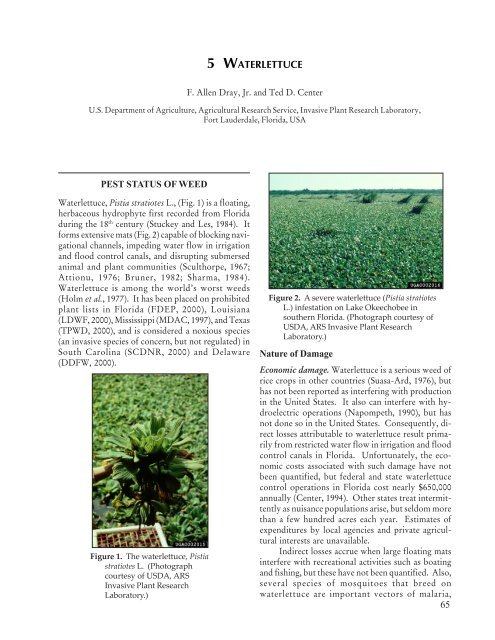


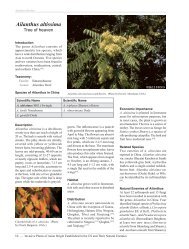
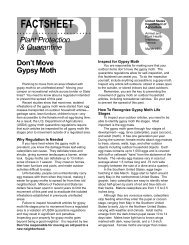
![A Guide to the Control and Management of Invasive Phragmites [PDF]](https://img.yumpu.com/27321025/1/190x190/a-guide-to-the-control-and-management-of-invasive-phragmites-pdf.jpg?quality=85)
